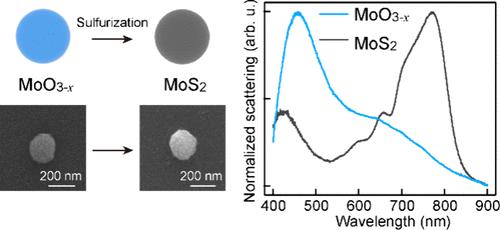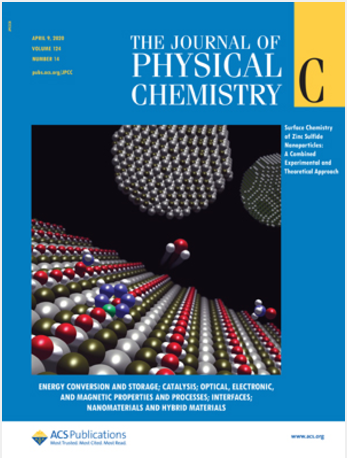将等离子体 MoO3-x 纳米粒子转化为介电 MoS2 纳米粒子
IF 3.3
3区 化学
Q2 CHEMISTRY, PHYSICAL
引用次数: 0
摘要
本文章由计算机程序翻译,如有差异,请以英文原文为准。

Transformation of Plasmonic MoO3–x Nanoparticles into Dielectric MoS2 Nanoparticles
Transformation from plasmonic to dielectric properties allows for control over light–matter interactions, enabling the development of nanoparticles that can dynamically adjust their optical characteristics and enhance their functionalities. The exploration of the transformation aligns with the demand for applications in adaptive optics and responsive photonic devices. The transformation of metal plasmonic nanoparticles to dielectric nanoparticles typically requires a complex structure design while ensuring the preservation of their original morphology. Herein, we report on the transformation of plasmonic MoO3–x nanoparticles into dielectric MoS2 nanoparticles. The plasmonic properties of MoO3–x nanoparticles, prepared by aerosol spray, were investigated at the single-particle level. A comprehensive analysis of the size-dependent electromagnetic resonances of the product nanoparticles was conducted from both experimental and simulation perspectives. The transformation process was carried out in a tube furnace under a sulfur atmosphere, allowing for a complete change in optical response from plasmonic MoO3–x nanoparticles to dielectric MoS2 nanoparticles. The degree of transformation can be controlled by varying the sulfurization time with the formation of (MoO3–x core)@(MoS2 shell) nanostructures. Our results demonstrate a potential strategy for transforming plasmonic nanoparticles into dielectric nanoparticles.
求助全文
通过发布文献求助,成功后即可免费获取论文全文。
去求助
来源期刊

The Journal of Physical Chemistry C
化学-材料科学:综合
CiteScore
6.50
自引率
8.10%
发文量
2047
审稿时长
1.8 months
期刊介绍:
The Journal of Physical Chemistry A/B/C is devoted to reporting new and original experimental and theoretical basic research of interest to physical chemists, biophysical chemists, and chemical physicists.
 求助内容:
求助内容: 应助结果提醒方式:
应助结果提醒方式:


